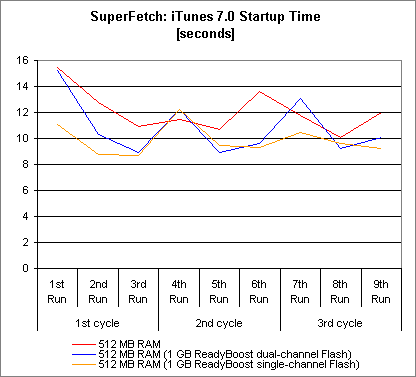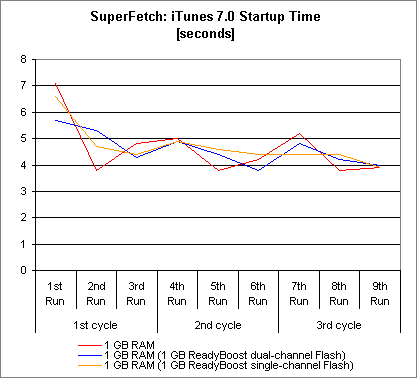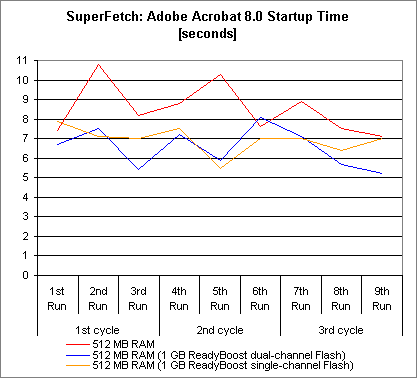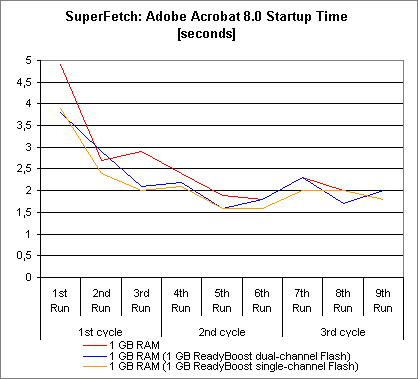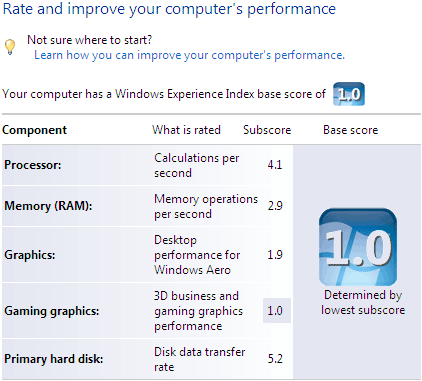Analysis: Vista's Ready Boost is no match for RAM
ReadyBoost application performance, Continued
Apple iTunes 7 startup time
For Apple's iTunes 7 and 512 MB RAM, SuperFetch reduces the launch time from 15 seconds at the initial start to 10-12 seconds over time. If you add one of our USB 2.0 Flash memory devices, you can save another 2-3 seconds.
By having 1 GB or RAM instead of 512 MB, the time to launch iTunes 7 drops from 8-15 seconds to as little as 4-7 seconds!
Adobe Acrobat 8 Reader startup time
Acrobat Reader 8, launched by double-clicking our 22 MB pdf document, requires 8-10 seconds to launch. This benchmark chart shows clearly that Adobe Acrobat Reader 8 and Windows Vista eat up all the available 512 MB RAM, because SuperFetch does not show much of a positive effect. The result is entirely different if a USB 2.0 Flash drive is added for the purpose of serving ReadyBoost: Starting the document now takes between 6 and 8 seconds.
Nobody should be surprised that this procedure takes only 2-5 seconds with more RAM. 1 GB of RAM has tremendous advantages over 512 MB in terms of application startup performance! Adding a memory stick still increases performance, though.
Conclusion: Get 1 GB of RAM, then get Vista, then consider using a USB stick
Our first intention was to analyze the impact of different USB 2.0 Flash memory devices, but we quickly determined during our testing that the performance delta between very little and ample main memory size is the key requirement for Windows Vista performance. We can't help but stressing that 512 MB RAM just does not cut it.
Although an additional USB 2.0 Flash memory device clearly helps to increase application responsiveness at launch time (we've experienced time savings in this area of up to 50%), upgrading an average computer from 512 MB to at least 1 GB of RAM makes a huge difference. Microsoft may argue that adding a Flash memory stick already has a tremendous impact on subjective performance, reducing application launch times considerably. And that's all true; the performance impact is considerable, but Windows Vista still remains slow in the end.
The performance gain that is achieved from going from 512 MB to 1 GB, which is a very affordable decision nowadays, is absolutely worth the money, even if you have to drag your computer into a local PC store and have service people take care of the upgrade.
Get Tom's Hardware's best news and in-depth reviews, straight to your inbox.
ReadyBoost is a nice feature, but it is an extension to SuperFetch, which is the basis for all performance improvements we observed. If you have a fast USB 2.0 Flash memory stick it doesn't hurt to use it. But the big deal has always been getting enough RAM. After all we're talking about Windows: Some things never change.
More RAM will influence the Windows Vista performance rating. A USB 2.0 Flash memory drive for use with ReadyDrive won't.
Current page: ReadyBoost application performance, Continued
Prev Page ReadyBoost application performance
Patrick Schmid was the editor-in-chief for Tom's Hardware from 2005 to 2006. He wrote numerous articles on a wide range of hardware topics, including storage, CPUs, and system builds.
